|
|
File
National Museum of Concordia – Portogruaro
|
Via del Seminario 26 – 30026 Portogruaro (VE)
– Fax 0421 72674 |
  |
|
Summary
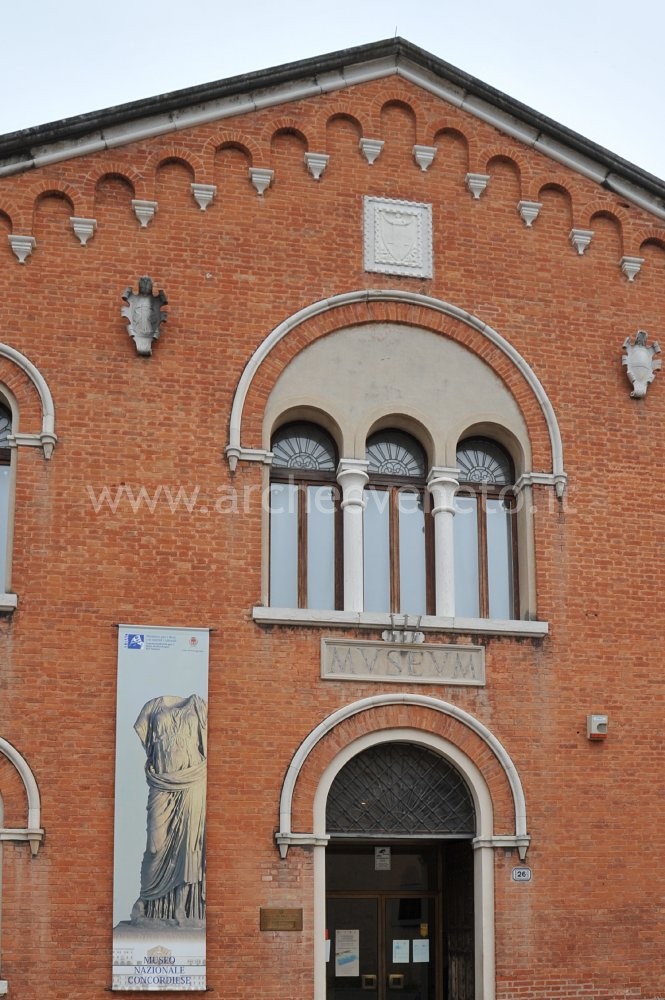
The building has two floors. On the ground floor there is a hall and a large room with three aisles (basilica). This floor hosts architectural exhibits, funeral stele, portrays and epigraphic material arranged according to the antique standards of the 1800s. On the floor along the central nave there are three mosaic pavements, two with geometrical motives and the third with The Three Graces.
The adjacent room, on the right hand side from the entrance houses decorative elements from public and private living areas of Concordia as well as coins found in Concordia’s countryside. On the first floor the displays hold the materials found by local collectors and by Dario Bertolini in his excavation works at the end of the 19th century. These are artefacts from the pre-Roman and Roman times of the city, such us some bronze figures. Further down there are some fragile exhibits divided in groups: glass, stones, amber adornments, lamps and other every day use objects. Finally there is a collection of various objects found during excavation works in Consordia Sagittaria
Collection history
The core of the Museum was founded at the end of 1700’s by the materials provided by Muschietti, a family of local collectors. The collection was then passed, in line with their last will, to Comune of Portogruaro (second half of the 19th century) and was temporarily kept in the Town Hall. At the end of the 19th century, as more material was found during excavation works in the urban area and the ‘military cemetery’ of Concordia Sagittaria the need for an appropriate building that could contain all the collections was becoming extremely pressing. Thanks to the initiative and persistence of Dario Bertolini and Giuseppe Giorelli, then Head of the exploration works, the Municipality purchases land in via Seminario and the Ministry financed the construction of Concordia Museum. The milestone was set in 1885 and the Museum was opened on the 28th of October 1888. It was completely renovated and re-opened in 1986. The renovated objects are presented in display cabinets whereas the stone findings were kept in their original set up, perfectly illustrating the collecting methods in those days.
|

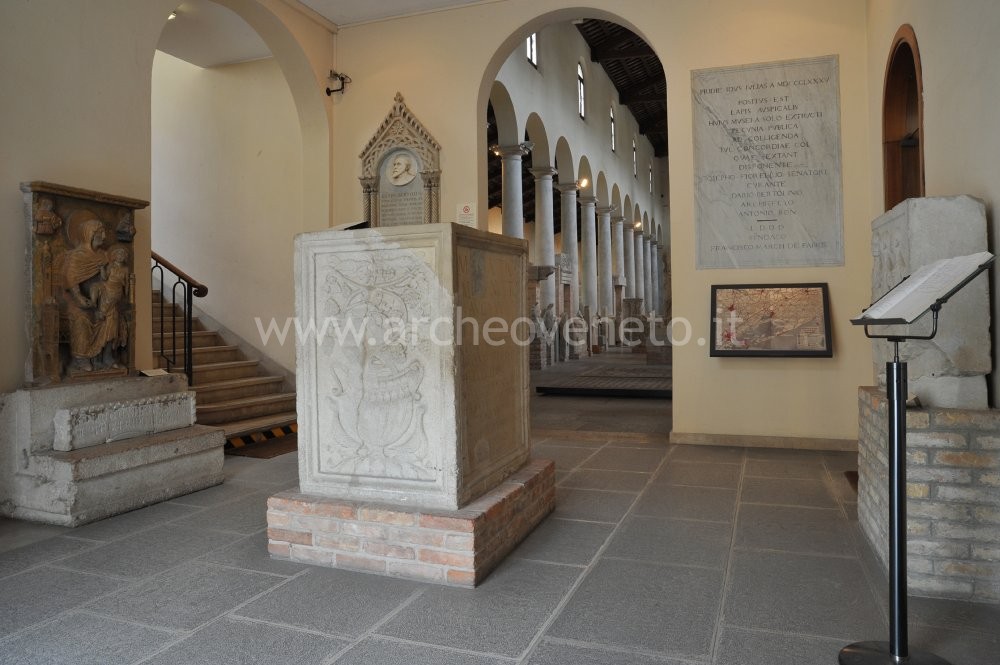 The atrium hosts interesting stone artefacts, among others a relief with three lictors dressed in short tunics and a cape, probably taking part in some sort of sacrifice ritual. It is dated to the 1st century AD. Also in this section there is an altar entitled Marcus Acutius Noetos decorated with beautiful bas-reliefs presenting a vase full of wine tree branches covered with birds and two birds on either side of it. From the same altar, according to Dario Bertolini, comes a sculpture of Madonna and Child on a throne, discovered in the 13th century. The atrium hosts interesting stone artefacts, among others a relief with three lictors dressed in short tunics and a cape, probably taking part in some sort of sacrifice ritual. It is dated to the 1st century AD. Also in this section there is an altar entitled Marcus Acutius Noetos decorated with beautiful bas-reliefs presenting a vase full of wine tree branches covered with birds and two birds on either side of it. From the same altar, according to Dario Bertolini, comes a sculpture of Madonna and Child on a throne, discovered in the 13th century.
|

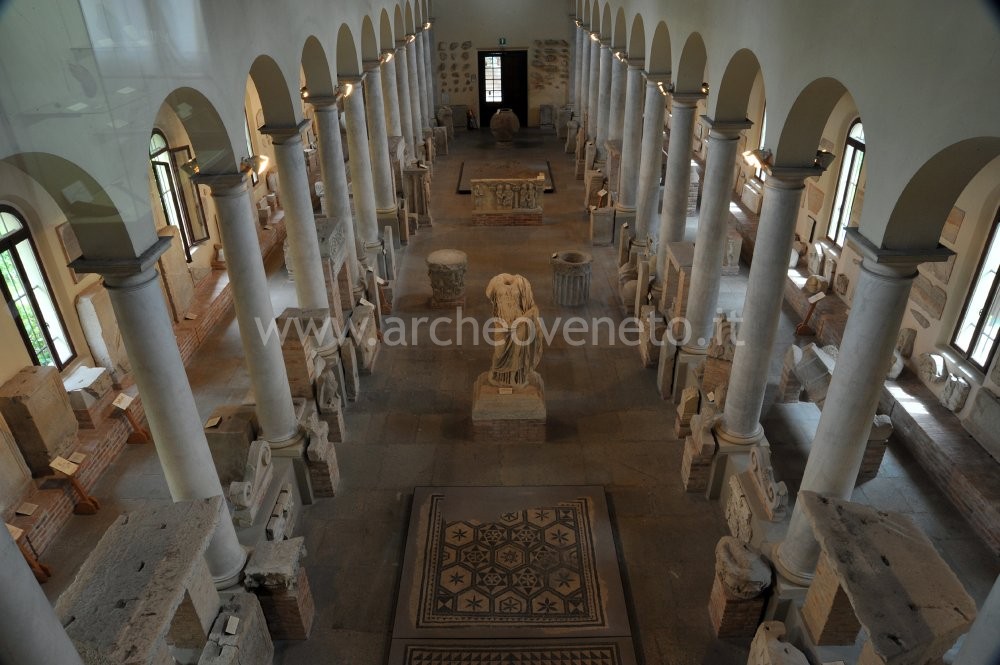 This room hosts the majority of findings from Concordia. The objects are presented along the left and right aisles, according to their chronological order. In the central nave there are fragments of architectural elements of public buildings (e.g. an architrave from a city theatre from the 1st century AD). Other exhibits include: capitals and column drums, findings from Roman necropolises of Concordia along via Annia outside of the city walls (stelae from aedicule – like the one of Cornelli family, grave stones – like the one of F. Galla with decorations representing tool sets and a gammon, pieces of tomb ceilings – like the coffer ceiling decorated with a scene of Ganymede being kidnapped by an eagle). One monument stands out particularly: a headless statue of a woman in Luni marble, potentially part of a larger group. Nearby there is a mosaic pavement partly with geometric motives (from the 1st century AD) and partly with figurative motives (Three Graces) from the 3rd century AD. In the left aisle there are numerous inscriptions, pagan and Christian, dedicated both to ordinary people as well as to notable citizens who used to perform public duties for the city. The inscriptions reflect the position within the social hierarchy these people used to represent along the streets and within the most important institutions. Finally, the aisle on the right holds the objects found in the ‘military cemetery’ between 1873 and 1876. These include over 260 sarcophaguses, sculptures, stele and inscriptions from between the end of the 4th and the 5th century AD. This room hosts the majority of findings from Concordia. The objects are presented along the left and right aisles, according to their chronological order. In the central nave there are fragments of architectural elements of public buildings (e.g. an architrave from a city theatre from the 1st century AD). Other exhibits include: capitals and column drums, findings from Roman necropolises of Concordia along via Annia outside of the city walls (stelae from aedicule – like the one of Cornelli family, grave stones – like the one of F. Galla with decorations representing tool sets and a gammon, pieces of tomb ceilings – like the coffer ceiling decorated with a scene of Ganymede being kidnapped by an eagle). One monument stands out particularly: a headless statue of a woman in Luni marble, potentially part of a larger group. Nearby there is a mosaic pavement partly with geometric motives (from the 1st century AD) and partly with figurative motives (Three Graces) from the 3rd century AD. In the left aisle there are numerous inscriptions, pagan and Christian, dedicated both to ordinary people as well as to notable citizens who used to perform public duties for the city. The inscriptions reflect the position within the social hierarchy these people used to represent along the streets and within the most important institutions. Finally, the aisle on the right holds the objects found in the ‘military cemetery’ between 1873 and 1876. These include over 260 sarcophaguses, sculptures, stele and inscriptions from between the end of the 4th and the 5th century AD.
|

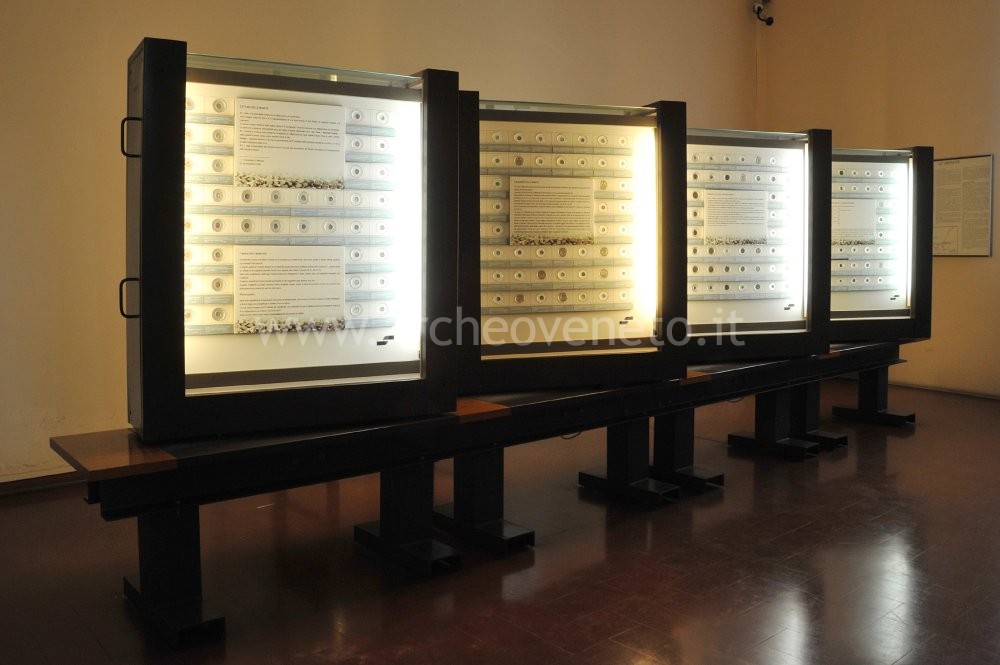 This room hosts predominantly portrays from the 1st and 2nd century AD. Among numerous portrays there is one of a young woman with wavy hair and a fruit and flower crown, most likely from the Flavian Age. There are also three discs with Gorgon faces, one marble frieze with Giove Ammone mask, two hermai with the adornments in the shape of Satyrs and Bacchae, one plate with the scene of Leda and the Swan, two oscillum (decorative elements usually hung up above the porches) decorated on each side. Finally, there is a rich collection of coins from Concordia territory presented in an appropriate display cabinet. This room hosts predominantly portrays from the 1st and 2nd century AD. Among numerous portrays there is one of a young woman with wavy hair and a fruit and flower crown, most likely from the Flavian Age. There are also three discs with Gorgon faces, one marble frieze with Giove Ammone mask, two hermai with the adornments in the shape of Satyrs and Bacchae, one plate with the scene of Leda and the Swan, two oscillum (decorative elements usually hung up above the porches) decorated on each side. Finally, there is a rich collection of coins from Concordia territory presented in an appropriate display cabinet.
|

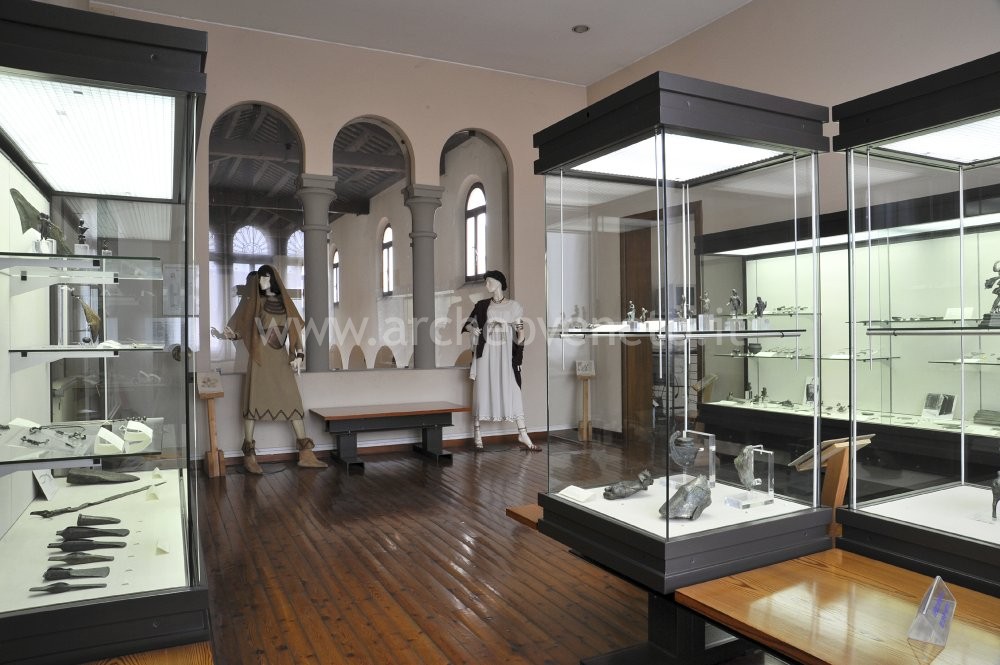 This first floor room hosts numerous bronze objects from Concordia and its surroundings. The exhibits are divided into two groups: of pre-/Protohistoric production (among others a statue of a lyre player and a thin sheet with an inscription of Minerva) and Roman production. Worth mentioning is a small group of bronze statues representing Diana running with a dog and a fawn. It was found in Lison, along via Annia and it proves the widespread of the oriental cults in Concordia region during the 3rd century AD, as demonstrated by the dedication of the Syrian soldier, Tito Aurelio Seleuco. This first floor room hosts numerous bronze objects from Concordia and its surroundings. The exhibits are divided into two groups: of pre-/Protohistoric production (among others a statue of a lyre player and a thin sheet with an inscription of Minerva) and Roman production. Worth mentioning is a small group of bronze statues representing Diana running with a dog and a fawn. It was found in Lison, along via Annia and it proves the widespread of the oriental cults in Concordia region during the 3rd century AD, as demonstrated by the dedication of the Syrian soldier, Tito Aurelio Seleuco.
|

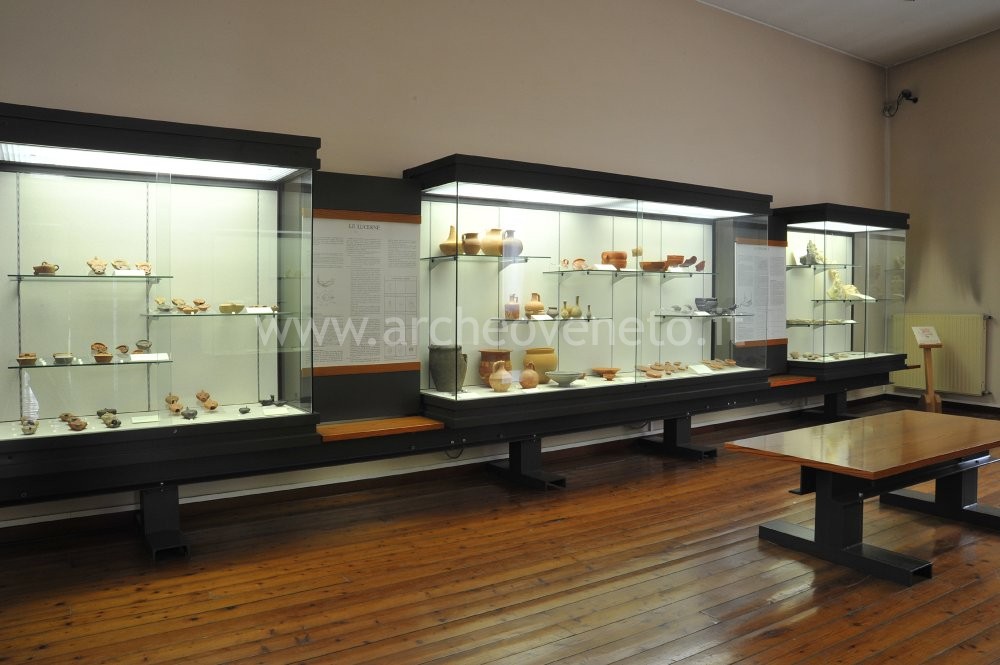 This room holds a range of objects made of various materials: glass (balm and unguent containers, little cups – like the one showing Daniele, the prophet, dated to the 4th century AD), stones (with divinity images, Dionysian personifications, mythological scenes and scenes from every day life). Also in this room you will find some stone exhibits – worth pointing out are the antefixes for rooftop decoration (like the one with a tragic mask), Roman ceramic tableware (e.g. Samian ware, some of which of Saurius production) and lamps. Especially worth mentioning is a group of thin lead sheets carrying inscriptions that specify the type and weight of transported materials (then sold in Concordia centre). This room holds a range of objects made of various materials: glass (balm and unguent containers, little cups – like the one showing Daniele, the prophet, dated to the 4th century AD), stones (with divinity images, Dionysian personifications, mythological scenes and scenes from every day life). Also in this room you will find some stone exhibits – worth pointing out are the antefixes for rooftop decoration (like the one with a tragic mask), Roman ceramic tableware (e.g. Samian ware, some of which of Saurius production) and lamps. Especially worth mentioning is a group of thin lead sheets carrying inscriptions that specify the type and weight of transported materials (then sold in Concordia centre).
|

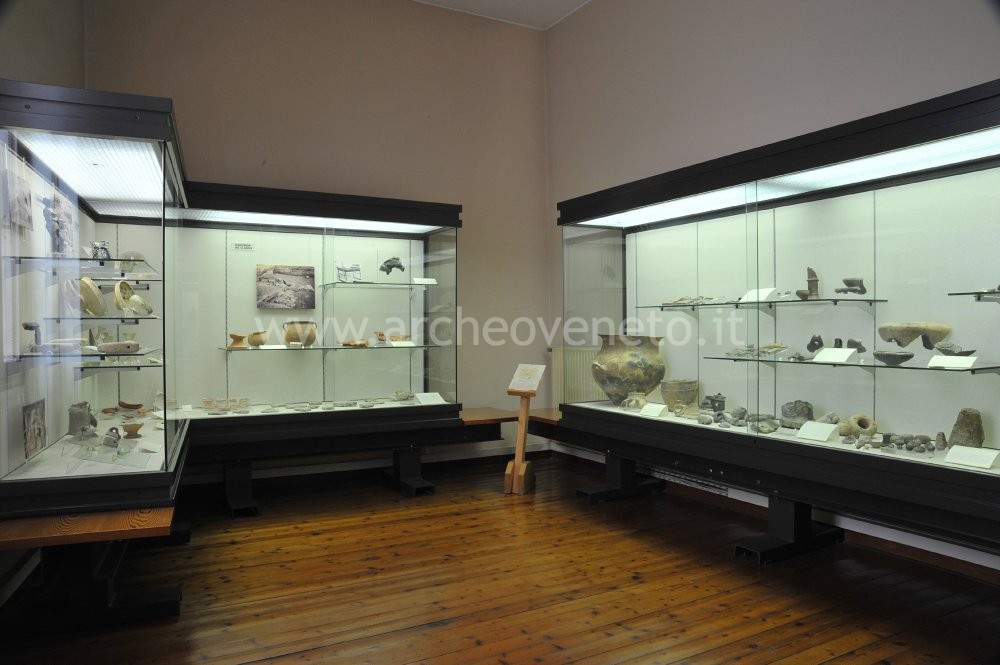 The last room is dedicated to the archaeological findings from the last thirty years: the exhibition follows a chronological order from Late Bronze Age (13th – 12th century BC) through the first Iron Age (10th – 8th century BC) all the way to the establishment of the colony, the whole Roman Age and Renaissance. The last room is dedicated to the archaeological findings from the last thirty years: the exhibition follows a chronological order from Late Bronze Age (13th – 12th century BC) through the first Iron Age (10th – 8th century BC) all the way to the establishment of the colony, the whole Roman Age and Renaissance.
|
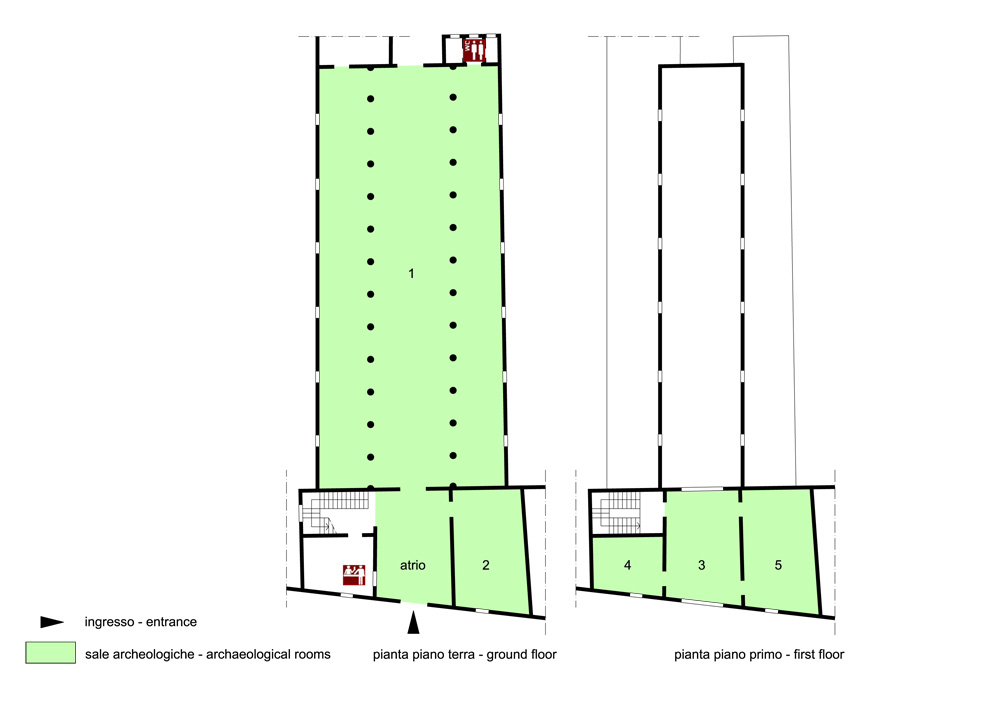
Admission: Negli orari di apertura
Ticket: Si
Price: Full price € 3; reduced price € 1,5; free entrance for under 18 and over 65
 School access School access
 Disabled access Disabled access
Limited to the firs floor
Opening Days
| Tipology |
When |
Specs |
| Summer/Winter |
Monday |
8.30 – 19.30 |
| Summer/Winter |
Tuesday |
8.30 – 19.30 |
| Summer/Winter |
Wednesday |
8.30 – 19.30 |
| Summer/Winter |
Thursday |
8.30 – 19.30 |
| Summer/Winter |
Friday |
8.30 – 19.30 |
| Summer/Winter |
Saturday |
8.30 – 19.30 |
| Summer/Winter |
Sunday |
8.30 – 19.30 |
Closed on 1 May, 25 December and 1 January. The ticket office closes at 7pm.
Recommended tour time (minutes): 60
 Toilet Toilet
 Guide a stampa Guide a stampa
Audio guide
 Information boards Information boards
 Captions under exhibits Captions under exhibits
 Multilingual ads: Francese Multilingual ads: Francese
Tedesco
Inglese
Leaflets
 Guided Tours Guided Tours
For any information, please cal tel. 0421 72674.
 Educational activities Educational activities
Teaching courses offered by the association "Studio D Friuli" (Francesca Benvegnù tel. 3463257139; e-mail: studiodfriuli@alice.it).
 Library and documentation centre Library and documentation centre
Library and historical archive
| Broilo F. 1980, Le iscrizioni lapidarie latine del Museo Concordiese di Portogruaro, I, Treviso. |
| Broilo F. 1983, Le iscrizioni lapidarie latine del Museo Concordiese di Portogruaro, II, Roma. |
| Larese A. 1983, Le lucerne fittili del Museo Concordiese di Portogruaro, Roma. |
| Lettich G. 1983, Le iscrizioni sepolcrali tardoantiche di Concordia, Trieste. |
| Croce Da Villa P. 2001, Il Museo Nazionale Concordiese di Portogruaro e le aree archeologiche di Concordia Sagittaria, Concordia Sagittaria. |
| Pettenò E., Toso S. 2006, A proposito delle gemme “incise a perfezione” del Museo Nazionale Concordiese di Portogruaro, in Quaderni di Archeologia del Veneto, XXII, pp. 199-211. |
| Pettenò E. 2007, La colonia di Iulia Concordia e la “collezione” del Museo Nazionale Concordiese di Portogruaro, in Vasa Rubra. Marchi di fabbrica sulle terre sigillate di Iulia Concordia, a cura di Pettenò E., Padova. |
| Pettenò E., Marano L. 2008, Un contributo per la storia del Museo Nazionale Concordiese di Portogruaro: la revisione degli Inventari relativa alla collezione storica, in Quaderni di Archeologia del Veneto, XXIV, pp. 226-230. |
| Pettenò E. 2008, Capitello di lesena, in Restituzioni. Tesori d’arte restaurati, Catalogo della mostra (Vicenza, 29 marzo – 29 giugno 2008), Venezia, pp. 62-65. |
| Pettenò E. 2008, Cinque vetri da Concordia Sagittaria, in Restituzioni. Tesori d’arte restaurati, Catalogo della mostra (Vicenza, 29 marzo – 29 giugno 2008), Venezia, pp. 70-73. |
| Pettenò E. 2008, Statuetta di Diana cacciatrice, in Restituzioni. Tesori d’arte restaurati, Catalogo della mostra (Vicenza, 29 marzo – 29 giugno 2008), Venezia, pp. 82-85. |
| Bonetto J. 2009, Veneto (Archeologia delle Regioni d’Italia), Roma, pp. 438-441. |
| Incise a perfezione. La collezione glittica del Museo Concordiese 2009, a cura di Pettenò E., Padova. |
| Pettenò E. 2009, La “Madonna in trono con Bambino di Portogruaro”. Memoria dell’antico al Museo Nazionale Concordiese, in Annali della Scuola Normale Superiore di Pisa. Classe di Lettere e Filosofia, s. 5, 1, pp. 165-188. |
| Di Filippo Balestrazzi E. 2012, Sculture romane del Museo Nazionale Concordiese di Portogruaro, Roma. |
|

